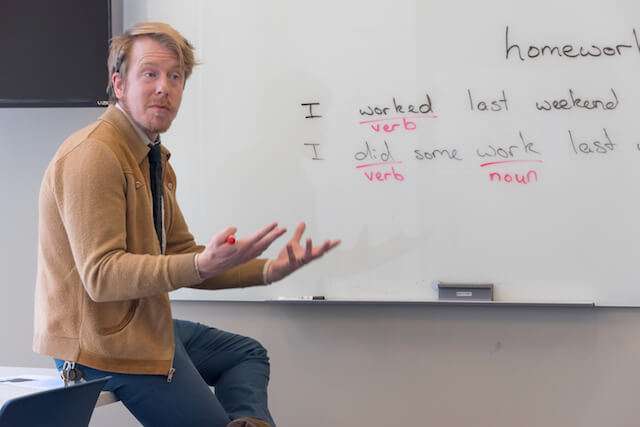If you’ve taught or tutored English (or any language), you’ve probably asked yourself on more than one occasion when, how, and even if, you should correct your students’ mistakes. While error correction in teaching English mainly depends on whether your lesson objective is fluency or accuracy (more on this below), in any case, there are certain key things to know when it comes to effectively – and sensitively – correcting your students’ mistakes in class.
If you’re new to teaching, you’ll want to get initial training and qualification with a TEFL certificate. You can explore our online TEFL courses to get started!
What is the difference between an error and a mistake?
You might be surprised to learn there’s a difference! Yet in teaching English, a distinction is made.
Mistakes
A mistake is an accident or a lapse, something that your EFL/ESL students actually know and that they can most likely self-correct if given the chance. This can be a typo, using the wrong word, or a small grammatical mistake.
Errors
An error, on the other hand, is something that your students don’t know because they haven’t learned it yet or they’ve forgotten it. This is where your students need you the most, in order to effectively correct their errors and help them develop their language skills.
What kind of errors do EFL/ESL students make in class?
Students make many mistakes during the long endeavor of learning a new language. This is a natural and necessary part of the learning process! As a teacher, it helps to identify the type of error in order to correct it effectively and smoothly.
Productive skills errors
Errors in spoken or written skills include vocabulary, pronunciation, and grammatical errors, as well as errors in producing intelligible language that can be understood globally.
Receptive skills errors
Errors in listening and reading skills include misinterpretation of content, misunderstanding of words, or simply the inability to comprehend someone’s speech in total.
You’ll learn more about other types of errors students make, such as global and local, in the Micro-credential course: Error Correction in the EFL Classroom.

When should I correct my students?
The timing of correcting students’ errors in teaching English is crucial to your lesson being a success or a fail. Error correction in EFL/ESL has a big impact on your students’ learning process and the right timing will help them retain new information effectively.
When to correct errors in fluency-based lessons
If you’re teaching a class or activity where fluency is the goal, try to monitor your students and take notes of major or repeating mistakes. Don’t interrupt your students’ speech. This might discourage them or make them lose the motivation to speak freely. Save the error correction for the end of the class.
At that time, you can give individual feedback or discuss the most important errors with the whole class if your students are okay with that. You could also prepare a quiz for the next lesson, touching on the major errors that you noted down while monitoring your students.
When to correct errors in accuracy-based lessons
If you’re teaching a class or activity that aims for accuracy, for example applying a new grammar rule during a conversation, you can correct immediately after the mistake has been made, assuming that it is a mistake about said rule. Since you just taught the content, you can encourage your students to self-correct their error first, or you can ask other classmates to help. Sometimes a gesture is enough to indicate the type of error. You don’t need to focus too much on mistakes students make that aren’t related to the current lesson, since this can again disrupt their efforts to use the newly learned grammar.
If you notice during the activity that your students are making the same errors over and over again, you might want to stop the activity, review the lesson content and resume the practice after making sure that all your students have understood the new rule.
Dos and Don’ts of error correction
Here are some useful ground rules for error correction in the English classroom, whether you’re teaching online lessons or in a live classroom. For more detailed tips and tricks, check out the Bridge Micro-credential course: Error Correction in the EFL Classroom!
Dos

Dont’s
The importance of error correction in the EFL/ESL classroom
We learn by making mistakes. As children, we learn how to walk by falling over hundreds of times. As adults, we learn a new language by making uncountable mistakes in the use of words, grammar, sentence structure, pronunciation, and register. The most important thing for you as an English teacher is to correct your students’ errors effectively and sensitively. Only then can you help them grow and develop their newly acquired language skills at their own pace and in a comfortable and safe environment.
Learn more about correcting students’ errors effectively
If you’re a new teacher and want to level-up your teaching skills as well as learn more about error correction techniques in the classroom, start with the comprehensive Bridge Master Certificate TEFL/TESOL course.
If you’re an experienced teacher, sign up for the Bridge Micro-credential course: Error Correction in the ESL Classroom to develop additional skills, and you’ll have the option to earn a digital badge to show off your credentials on your TEFL resume and social networks!











